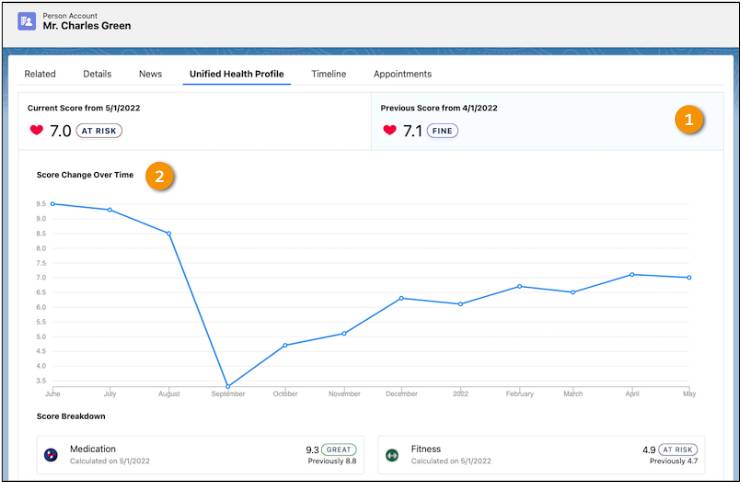Meet Unified Health Scoring
Learning Objectives
After completing this unit, you’ll be able to:
- Explain why it’s important to consider the whole health of a patient.
- Discuss the benefits of using Unified Health Scoring in your organization.
- Describe typical use cases for Unified Health Scoring.
Whole Health of Patients
April Guthman is a care coordinator at Bloomington Caregivers, a home healthcare agency that provides care for the elderly. The agency has 3,000 patients, who receive care in their homes instead of the more traditional healthcare facility setting.

April works with many patients at Bloomington Caregivers. She assesses their needs, creates personalized care plans, and manages and coordinates their care. Her patients mean a great deal to her. As she gets to know them, she’s fully aware that numerous factors influence their health. Clinical variables like medical diagnoses and lab test results play a large part in understanding patient health, but there’s more to the story. Nonclinical factors also affect wellbeing, such as where they live, their financial situation, and how likely they are to take their medication.
April knows these factors aren’t necessarily measurable with a lab test or from a doctor’s office visit. However, she believes that evaluating the whole health of her patients can help prevent diseases and stop the progression of existing ones.

April uses Health Cloud to manage her patients’ health, where she can see patient profiles at a glance. She wonders if there’s a simple way to view the whole health of her patients in a quantifiable form and reaches out to Harryette Randall, Bloomington’s Salesforce administrator.

Harryette, a Health Cloud expert, has implemented Unified Health Scoring for other teams at Bloomington Caregivers. She knows that this feature would help April and her team to understand the whole health of their patients.
Let’s discover Unified Health Scoring and how it gives a holistic view of patient health.
Unified Health Scoring
Unified Health Scoring analyzes factors that affect patient health to give healthcare organizations a patient health score. The health score can derive from clinical and nonclinical factors, depending on the patient characteristics the organization wants to assess. The score forms the basis of a Unified Health Profile.
Here’s an example of a Unified Health Profile for Charles Green, a patient at Bloomington Caregivers.

The Unified Health Profile displays the current and previous score information (1). It also displays a graph that shows score changes over time (2). Bloomington Caregivers can review this score and adjust the care the patient is receiving as needed.
Unified Health Scoring recommends appropriate actions to improve patient scores. Bloomington has to decide what actions to recommend and under what circumstances. For example, when a patient score falls due to missed appointments, Unified Health Scoring suggests sending emails to remind the patient of upcoming appointments.
Unified Health Scoring Benefits
With Unified Health Scoring, healthcare agencies can:
- Focus on the whole health of the patient. The patient health score is based on clinical and nonclinical factors, including medical, demographic, financial, social, and behavioral aspects. Caregivers use the score to get a comprehensive snapshot of the patient's health.
- Get actionable insights, not just more data. You can find scalable action steps and treatment recommendations with the Dynamic Actions component of Unified Health Scoring. After all, you need to contextualize and act on the data you collect.
- Drive patient engagement. Guide behavioral change for patients through contextual actions so they can improve their health. Help patients see how and when they’re moving in the right direction in their treatment plan.
Impressive, isn’t it?
Typical Use Cases
Healthcare providers like Bloomington Caregivers aren’t the only ones to benefit from Unified Health Scoring. Other healthcare and life science organizations can adopt the feature with exciting results. Let’s take a look at some typical use cases.
| Who uses Unified Health Scoring? | How do they use it? |
|---|---|
|
Care coordinator |
Take direct care action based on changes in the patient's score. For example, call a patient to recommend treatment or prioritize patients who need immediate attention to receive care sooner. |
|
Population health team |
Segment the patient base for different purposes. For instance, put patients on predefined journeys if adherence scores drop by more than 5%. |
|
Clinical trial coordinator |
Prescreen and match eligible participants to the right study to speed up trial recruitment and reduce screening failures. For example, contact someone to participate in a trial if their compatibility score is higher than 8. |
Now you know what Unified Health Scoring is and how it benefits healthcare and life sciences organizations. Let’s take a look at the feature components in the next unit.
